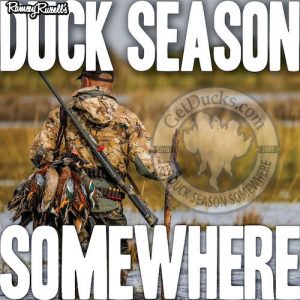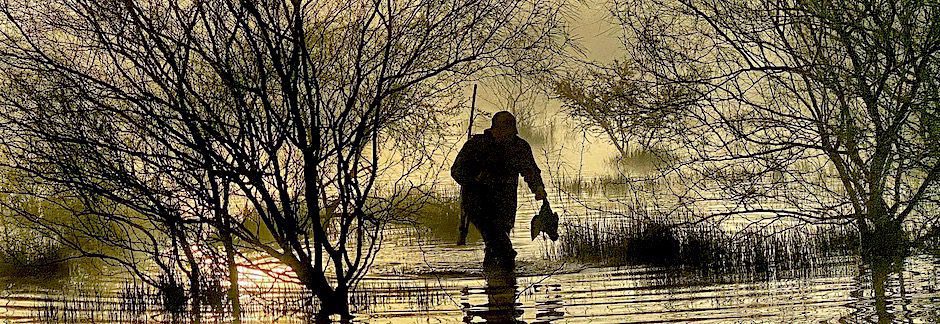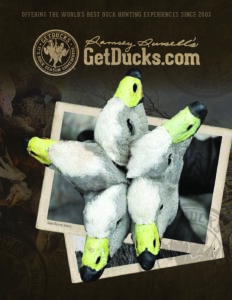MOJO’S Duck Season Somewhere Podcast
Q&A with Bigwater

Ramsey Russell and Mark Wilson aka Bigwater huddle around a table in the A/C on a hot summer afternoon. Bigwater talks about a recent trip to Omaha. He then asks Ramsey questions from listeners and himself, anything from packing light to what goes on behind the scenes at GetDucks while not traveling to thoughts on hunting pressure. Got a question or topic you’d like to hear? Inbox Ramsey at @ramseyrussellgetducks, or email ramsey@getducks.com.
Prairies Are Powder Keg Dry

It’s a scorching 107° F in North Dakota when Delta Waterfowl VP John Devney calls to give Ramsey Russell an update on the most cursed words that exist to a duck hunter’s ears: the Prairie Potholes Region is dry. Bad dry. Just how dry is it, and what drives drought cycle in the PPR? What’s “the biology of drought”? How’s this year compare to past droughts, and when did the lowest ever recorded pond counts occur? Why are there less Benellis afield killing half the number of mallards? We’ve not counted ducks in 2 years due to border closures, does Adaptive Harvest Management make allowances? Why does Devney describe the Pacific Flyway as suffering both natural and policy droughts? Any upside to this brutal cycle? The Duck Factory ain’t firing on all cylinders, folks. The western half of the entire US is dry as a sun bleached bone in the desert. Tune in to this and upcoming episodes to learn more about why it matters to you.
The Crystal Grill in Greenwood, Mississippi

In the sedate Mississippi Delta hamlet of Greenwood, population 14 thousand, the Crystal Grill has served ever-growing menu selections of made-from-scratch family recipes since 1933. Owner Johnny Ballas has been working there for as long as he can remember. Long-time friend Mike Rozier remembers back in the good old days, when he was 8 years old, that every duck hunter in Leflore County gathered there for home-made pancakes and sausage. How has the Mississippi Delta and duck hunting changed since then? Who was One Arm Jenkins and other colorful characters they remember? What are the “Scatters,” and what happened when Leflore County Hunting and Fishing Club dues went from $12 to $20? What have been favored menu items for nearly a century? Anywhere in the world, a proper taste of local culture is acquired by simply finding a table at the right restaurant. Because whether you’re talking the best veal cutlet on earth or duck hunting, it’s really all about people.
Giving Up Is Not an Option

Having grown up duck hunting California’s Bay Area and, later while in college, the Sacramento Valley, it was like a dream come true when Mike McVey graduated college, moved nearer to the Oregon border, and started hunting fabled Tule Lake. McVey has since been California Department Fish and Wildlife’s Wildlife Habitat Supervisor for Shasta Valley Wildlife Area. He describes the worse drought observed in decades, its effect on both waterfowl and habitat management. How exactly is the drought impacting Klamath Basin? Why’s this region especially important to Pacific Flyway waterfowl–and to American waterfowl hunters? What’s “reverse moist-soil management”? What is avian botulism, why is this region prone to outbreaks, how many ducks might it kill, what species are most susceptible? How’s duck hunting changed since McVey’s been there? How important are hunters – and hunting revenues? And why does McVey say, “to give up is unacceptable?” Fast-paced as a sleek, well-used semi-auto shotgun, today’s episode is as interesting as informative.
A Duck’s Eye View of Southeastern US Waterfowl Habitat

Today’s guest is a self-described super nerd that played college ball, knew he wanted to be a biologist since childhood, and remembers falling in love with ducks when a flock of wigeons pitched into an Oklahoma farm pond he was hunting. Dr. Heath Hagy is now US Fish and Wildlife Service Waterfowl Ecologist for the National Wildlife Refuge System in the Southeastern United States. Using broad research and applied habitat experiences, Hagy works with 131 Federal Refuges, states and other entities managing waterfowl habitat resources. How does Federal Refuge habitat management compliment surrounding land uses, and why is the landscape level considered? How important are emergent marsh habitats for waterfowl, how might managers increase invertebrate biomass? What are wetland habitat complexes, why are they extremely important to how waterfowl perceive and use geographical areas? Why is habitat quality and quantity a moving target–and might there really be duck food deficits in parts of the Mississippi Alluvial Valley? What about water versus food as limited resources? How might hunting pressure have changed things in the past couple decades, and could it affect waterfowl distribution? How important is waterfowl sanctuary? At the landscape level, how is waterfowl habitat changing across the southeastern United States? Why is the North American Model a crowning achievement in waterfowl management and what makes it possible? Like a plate heavy with gravy-topped goodness, this episode hits the spot, addressing many of those duck-related topics that we hunters wonder aloud among ourselves in duck blinds and around tailgates nationwide.
Of Lion King Mentalities and Trophy Truths

While shooting barnacle geese and greylag geese together in the Netherlands decade ago, Ramsey Russell and Brian Lynn could never have imagined the ferocious battles with embittered anti-hunting crazies awaiting their respective futures. As VP Marketing and Communications for Sportsmen’s Alliance, Lynn now daily fights anti-hunters tooth-and-nail, wielding facts and advocating policy like a modern day dragon slayer. Who knew Dutch anti-hunters read American hunting magazines, and what lead to Ramsey Russell’s name being shouted by politicians in Netherlands Parliament? How could anti-hunters be described demographically, what triggers them, and what does money have to do with anything? What’s behind the Oregon Ballot Initiative, calling for complete cessation of hunting and fishing? How’d laws banning coyote hunting contests in the Southwestern US bounce through Blue and Red states alike, escalating into proposals that could ban retriever hunt tests, make breeding a sexual abuse crime, or make possessing “any wildlife” a felony? Long after most of us forgot all about Cecil the Lion, how has federal language since been appropriated to ban wildlife import – and what interests do EU and US have in Africa wildlife anyways?! This fascinating discussion is going to be a real kick in the cajónes to anyone thinking that our hunting lifestyle is a God-given right in America. It ain’t.
Related Links:
Potential Ballot Initiative in Oregon Proposes Ending All Hunting, Fishing, Trapping
Oregon: Epicenter of New Vegan World Order
Commercial Duck Hunting Undesirable in Netherlands Newspaper Story
Where Satisfaction Intersects Experience and Expectations

Michael Brasher grew up hunting with his dad, plying Mississippi’s Skuna River bottoms with a 4hp outboard. He now remembers a first mallard propelled his life towards eventually becoming Waterfowl Scientist at Ducks Unlimited HQ. What is DU’s role in North American waterfowl conservation, and why does Brasher say “conservation without funding is just conversation”? How’d Brasher get from there to here? What are some of the interesting socio-biological observations made while researching paired versus unpaired greenheads? Why are these challenging times? How are quality and quantity sometimes at odds? What’re the greatest challenges in waterfowl habitat conservation today? What compels Brasher in his chosen career? Waterfowl abundance doesn’t happen by accident. Today’s episode sheds a little more light on the dedicated people working behind the scenes to make it happen.
Wildlife Artist Rebekah Knight

The United States’ Federal Duck Stamp is singularly the most amazing waterfowl conservation tool in the world, generating over a billion dollars since its inception. Growing up in southwest Kansas, Rebekah Knight won the Federal Junior Duck Stamp at age 15, competing ever since. How did Knight become an artist and why did she start competing in the Federal Duck Stamp contest? How does she decide which species, how does she prepare and how much time goes into it? Why does Knight describe the relatively small circle of Federal Duck Stamp artists as family? The US Fish and Wildlife Service’s proposed removal of “celebrating our waterfowl hunting heritage” theme from the duck stamp contest recently caused a stir among hunters, but what’s the backstory, how and why do wildlife artists feel about the proposal? Federal Duck Stamps are now available, a sure sign we’re in the homestretch to duck season.
Not Where You Start, It’s Where You Finish

Before John Gordon was Senior Communication Specialist for Ducks Unlimited, he hunted waterfowl and was even a snow goose guide way back in the real, good old Katy, Texas Prairie days. Following a Memphis BBQ lunch, Gordon and Ramsey talk then-versus-now across several topics. What does Gordon do at Ducks Unlimited, what are his waterfowling origins? How’d they hunt snow geese way back when, what were the limits and how have things since changed? Who was “Dex the Wonder Dog,” why was running hunt tests kind of a big deal, and how’d he prove like only a retriever can that it’s not where you start it’s where you finish?
Landscape-level Waterfowl Conservation, Scott Stephens

Scott Stephens and Ramsey Russell went to Mississippi State University together way back when. Stephens is now Ducks Unlimited Canada’s Director of Regional Operations for Prairies and Boreal Forest, where he directs waterfowl conservation efforts over an almost unimaginably huge portion of North America–way, way bigger than the narrow 100-mile corridor bordering Yellowhead Highway that Ramsey Russell thinks of as Manitoba! Why does Stephens facetiously tell people that he “doesn’t really do anything anymore”? How bad is this year’s drought throughout Canada? What are long-term and short-term effects, and why does Stephens see a golden opportunity? Regards meaningful, landscape-level waterfowl conservation, what major industries are becoming ardent stakeholders in waterfowl habitat conservation efforts? Is this what Stephens imagined himself doing many years ago, what drives him? Plenty silver linings to consider in this informative episode.
Learn More: Escape From Medocrity, Johnny Lynch (1984)








